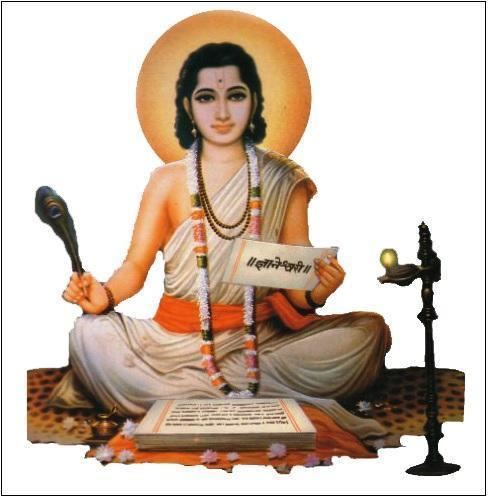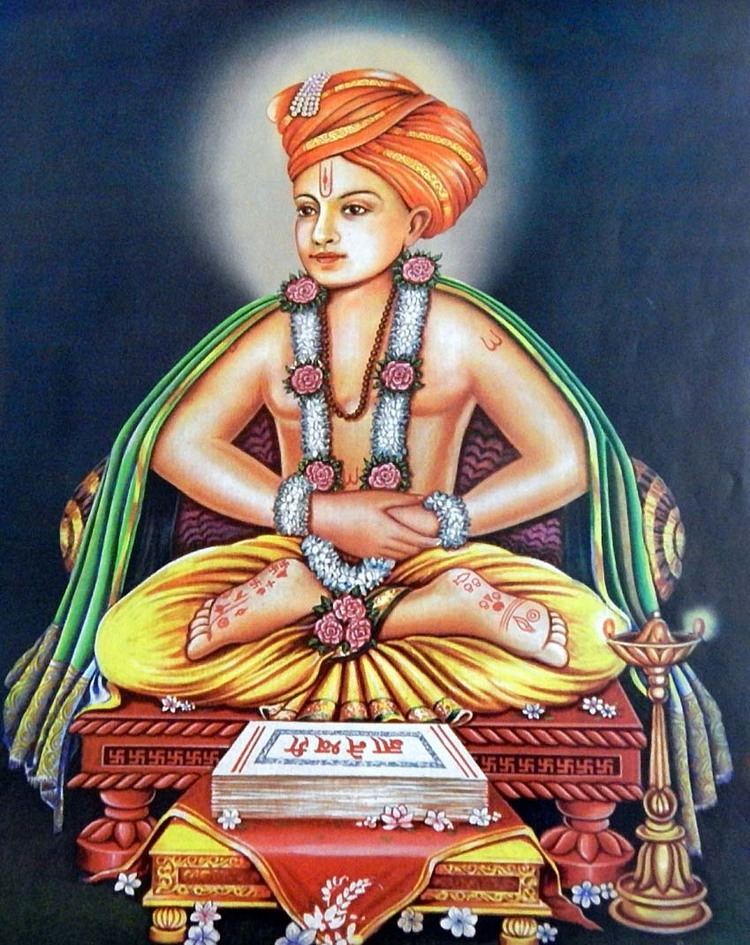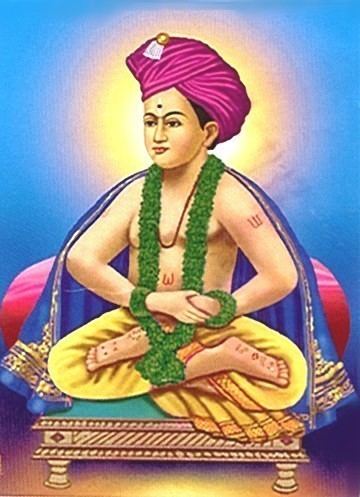Name Saint Dnyaneshwar Books Jnaneshvari | Role Poet Siblings Muktabai, Nivruttinath | |
 | ||
Parents Vitthala Pant, Rukmini Bai Similar People | ||
Sant dnyaneshwar marathi classical movie
Dnyaneshwar or Dnyandev or simply Mauli (IAST: Jñāneśvar) (1275–1296) was a 13th-century Marathi saint, poet, philosopher and yogi of the Nath tradition whose Dnyaneshwari (a commentary on the Bhagavad Gita) and Amrutanubhav are considered to be milestones in Marathi literature.
Contents
- Sant dnyaneshwar marathi classical movie
- Sant dnyaneshwar aarti with lyrics sanjeevani bhelande marathi devotional songs
- Background
- Early life
- Writings
- Influences
- Travel and samadhi
- Miracles
- Ontology and epistemology
- Ethics
- Reception and legacy
- Works
- References

Sant dnyaneshwar aarti with lyrics sanjeevani bhelande marathi devotional songs
Background

Dnyaneshwar was born in 1275 (on the auspicious day of Krishna Janmashtami) in Apegaon village on the bank of Godavari River near Paithan in Maharashtra during the reign of the Yadava king Ramadevarava., The kingdom enjoyed peace and stability until invasions from the Delhi Sultanate started in 1296 CE. Arts and sciences flourished under the patronage of the Yadava kings and Maharashtra attracted scholars from all over India. However, this period also witnessed religious degeneration, sectarianism, superstition and ritualism which involved animal sacrifices to many local deities. Dnyaneshwar would later criticise the religious degeneration of the day in his magnum opus Dnyaneshwari. According to B. P. Bahirat, Dnyaneshwar emerged as the first original philosopher who wrote in the Marathi language, in this era.

Biographical details of Dnyaneshwar's life are preserved in the writings of his contemporary Namdev and his disciples Satyamalanath and Sachchidanand. The various traditions give conflicting accounts of details of Dnyaneshwar's life. The date of composition of his work Dnyaneshwari (1290 CE), however is undisputed. According to the more accepted tradition on Dnyaneshwar's life, he was born in 1275 CE and died in 1296 CE.
Early life

Dnyaneshwar's father Vitthalapant was the kulkarni (hereditary accountant, usually Brahmin, who maintained land and tax records in villages) of a village called Apegaon on the banks of the Godavari River in Maharashtra, a profession he had inherited from his ancestors. He married Rakhumabai, the daughter of the kulkarni of Alandi. Even as a householder, Vitthalapant longed for spiritual learning. His disillusionment with life grew as a result of the death of his father and because he had no children from his marriage. Eventually, with his wife's consent, he renounced worldly life and left for Varanasi to become a sannyasin (renunciate).

Vitthalapant was initiated as a sannyasin by his spiritual teacher, Ramashrama, who is also called Ramananda, Nrisimhashrama, Ramadvaya and Shripad in various sources. (He was not Ramananda, the founder of the Ramanandi Sampradaya.) When Ramashrama discovered that Vitthalapant had left his family behind to become a monk, he instructed Vitthalapant to go back to his wife and perform his duties as a householder. After Vitthalapant returned to his wife and settled down in Alandi, Rakhumabai gave birth to four children—Nivruttinath (1273 CE), Dnyaneshwar (1275 CE), Sopan (1277 CE) and Muktabai (1279 CE).
Orthodox Brahmins of the day saw a renunciate returning to his life as a householder as heresy; Vitthalapant and his family were persecuted because of this. Dnyaneshwar and his brothers were denied the right to have the sacred thread ceremony, which in Hinduism symbolises the right to read the Vedas.
Vitthalapant eventually left the town for Nashik with his family. One day while performing his daily rituals, Vitthalapant came face to face with a tiger. Vitthalapant and three of his four children escaped, but Nivruttinath became separated from the family and hid in a cave. While hiding in the cave he met Gahaninath, who initiated Nivruttinath into the wisdom of the Nath yogis. Later, Vitthalapant returned to Alandi and asked the Brahmins to suggest a means of atonement for his sins; they suggested giving up his life as penance. Vitthalapant and his wife gave up their lives, within a year of each other by jumping into the Ganges in the hope their children might be able to lead lives free of persecution. Other sources and local folk tradition claim that the parents committed suicide by jumping in the Indrayani River. However, orthodox Brahmins of the town still refused to accept the children as pure and suggested that they obtain a certification of atonement (śuddhi) from the pandits of Paithana, which was a centre of orthodox learning.
Writings
The Pandits of Paithana were struck by the spiritual learning and intellect of the four siblings and awarded them the certificate of purification. While returning to Alandi from the journey, the children halted at Nevase, where Dnyaneshwar composed Dnyaneshwari in the year 1290,, a commentary on Bhagavad Gita which later became a fundamental text of the Varkari sect. His words were recorded by Sacchidananda, who agreed to become Dnyaneshwar's amanuensis. Dnyaneshwari was written using the Ovi; a metre, which was first used to compose women's songs in Maharashtra, of four lines where the first three or the first and third lines rhyme and the fourth line has a sharp and short ending. According to W. B. Patwardhan, a scholar on Dnyaneshwar, with Dnyaneshwar the ovi "trips, it gallops, it dances, it whirls, it ambles, it trots, it runs, it takes long leaps or short jumps, it halts or sweeps along, it evolves a hundred and one graces at the master's command".
Having experienced the rigidity of the caste system and the dogmatism of scriptural learning, Dnyaneshwar was sympathetic towards issues of the common people. He chose the new vernacular Marathi language, as opposed to the classical Sanskrit language, as a means of expression so that spiritual learning could reach the masses who weren't well versed in Sanskrit. In the 13th century, his works presented a departure from the prevailing socio–cultural ethos of high–caste Hinduism, a trend which continued with other Bhakti poets across India.
According to tradition, Nivruttinath was not satisfied with the commentary and asked Dnyaneshwar to write an independent philosophical work. This work later came to be known as Amrutanubhava. Scholars differ on the chronology of the Dnyaneshwari and Amrutanubhav. Patwardhan has argued that Amrutanubhav is an earlier text than Dnyaneshwari because the latter is richer in use of metaphors and imagery, and displays greater familiarity with many different philosophical systems, such as Samkhya and Yoga. However, both Bahirat and Ranade disagree with this view pointing out that in Amrutanubhava, author displays familiarity with involved philosophical concepts such as Mayavada and Shunyavada, and while the text has simpler language, it reveals Dnyaneshwar's "philosophical depth".
Dnyaneshwar's devotional compositions called Abhangas are believed to have been formulated during his pilgrimage to Pandharpur and other holy places when he got initiated in to the Varkari tradition.
Influences
The Mahanubhava sect and the Nath Yogi tradition were two prominent movements during Dnyaneshwar's time that influenced his works. Mahanubhavas were devotees of Krishna who disregarded the caste system, the Vedas and the worship of the deity Vitthala. Dnyaneshwar differed significantly from Mahanubhava’s religious precepts. His thought was founded on the philososphy of the later Vedic texts such as the Upanishads and the Bhagavad Gita, and devotion to Vitthala formed the cornerstone of the egalitarian Varkari sect founded by Dnyaneshwar. However, the literary style adopted by Mahanubhava writers influenced Dnyaneshwar’s works. According to R. D. Ranade, Dnyaneshwar "stands to Mahanubhavas just in the same relation which Shakespeare stood to Elizabethan writers".
Dnyaneshwar was initiated into the Nath Yogi tradition by his brother Nivruttinath,sometime after the death of their parents; Sopana and Muktabai were initiated into the tradition by Dnyaneshwar himself. Founded by Gorakshanath, the Nath Yogi sect had introduced the system of Hatha Yoga, which emphasised on yogic poses and physical fitness. Gahaninath, a disciple of Gorakshanath, had initiated Nivruttinath into the Nath Yogi tradition. Dnyaneshwar's non-dualistic philosophy, usage of a vernacular language in his writing and an emphasis on yoga and oneness of Vishnu and Shiva were his inheritances from the Nath Yogi tradition.
The values of Universal brotherhood and compassion espoused in his works came from his interactions with the devotional Vitthala sect, a tradition which was already in existence during Dnyaneshwar's time. J. N. Farquhar also notes the influence of Bhagavata Purana on Dnyaneshwar's poetry.
Travel and samadhi
After Dnyaneshwar had written Amrutanubhav, the siblings visited Pandharpur where they met Namdev, who became a close friend of Dnyaneshwar. Dnyaneshwar and Namadev embarked on a pilgrimage to various holy centres across India where they initiated many people into the Varkari sect; Dnyaneshwar's devotional compositions called Abhangas are believed to have been formulated during this period. On their return to Pandharpur, Dnyaneshwar and Namadev were honoured with a feast in which, according to Bahirat, many contemporary saints such as "Goroba the potter, Sanvata the gardener, Chokhoba the untouchable and Parisa Bhagwat the Brahmin" participated. Some scholars accept the traditional view that Namdev and Dnyaneshwar were contemporaries; however, others such as W. B. Patwardhan, R. G. Bhandarkar and R. Bharadvaj disagree with this view and date Namdev to the late 14th century instead.
After the feast, Dnyaneshwar desired to enter into sanjeevan samadhi, a practice to sum up the life after entering into a deep meditative state. Preparations for the Sanjeevan samadhi were made by Namdev's sons. Regarding Sanjeevan Samadhi, Dnyaneshwar himself has emphatically talked about relation between higher awareness and light or pure energy in the form of electromagnetic radiation. On the 13th day of the dark half of the Kartik month of the Hindu Calendar, in Alandi, Dnyaneshwar, then was twenty one year old entered into sanjeevan samadhi. His samadhi lies in the Siddhesvara Temple complex in Alandi. Namdev and other bystanders grieved his passing. According to tradition, Dnyaneshwar was brought back to life to meet Namdev when the latter prayed to Vithoba for his return. Dallmayr writes that this testifies to "the immortality of genuine friendship and companionship of noble and loving hearts". Many Varkari devotees believe that Dnyaneshwar is still alive. They opposed a plan by archaeologists to insert a thin fiber optic camera into the chamber more than forty years ago.
Miracles
Many miracles came to be associated with Dnyaneshwar's life, one of which was the revival of his disciple Sachchidanand's corpse. During Dnyaneshwar's visit to Paithan, to obtain a certificate of purification, he was confronted with a man who violently lashed at an old buffalo. When Dnyaneshwar expressed concern for the animal he was ridiculed by Brahmins for being more concerned about a beast than the teachings of the Vedas. Dnyaneshwar retorted that the Vedas themselves held all life to be sacred and a manifestation of the Brahman. The outraged priests pointed out that his logic implied that beasts should be able to learn the Vedas as well. An undeterred Dnyaneshwar then placed his hand on the buffalo's forehead and it started reciting a Vedic song. According to Fred Dallmayr, the story signifies that "divine is not a property of the learned elite; rather, it is a spread out gift, a largesse, over all creation".
Dnyaneshwar was challenged by Changdev, an accomplished yogi who rode on a tiger with his magical powers, to replicate this feat. Dnyaneshwar humbled Changdev by riding on a moving wall. Dnyaneshwar's advice to Changdev was given in 65 verses called the Changdev Pasasthi. Changdev became a disciple of Dnyaneshwar's sister Muktabai.
Ontology and epistemology
Dnyaneshwar takes up the examination of being or brahman in Amrutanubhava. He considers being to be the substratum of thought which enables thought and cognition. Since being is prior to thought and concepts, it is distinct from Kantian categories, and methods of thought such as epistemological analysis cannot be applied to it. Dnyaneshwar believes that reality is Self–evident and does not require any proof. It antedates dualistic divisions into knower and known, existence and nonexistence, subject and object, knowledge and ignorance.
Dnyaneshwar highlights the limitations of the traditional epistemological methods (pramanas) used in Indian philosophy. He points out that any perception is validated only by another deeper understanding, while in establishing the rationality of reason, reason itself is transcended. Dnyaneshwar even cautions against reliance on scriptural testimony, which is accepted as a valid source of knowledge by philosophers of Vedanta and Mīmāṃsā schools of philosophy. Scriptural validity, to him, stems from its congruence with experiential truth and not vice versa.
Ethics
Dnyaneshwar's moral philosophy comes out in his exposition of the 13th of Bhagavad Gita, in his commentary on the book Dnyaneshwari. He considers humility; non–injury in action, thought and words; forbearance in the face of adversity; dispassion towards sensory pleasures; purity of heart and mind; love of solitude and devotion towards one's guru and God as virtues; and their corresponding moral opposites as vices. A pessimistic view of one's life is considered as a necessary condition for spiritual growth in Dnyaneshwari. Dnyaneshwar writes that saints do not perceive distinctions and are humble because they identify all objects, animate or inanimate, with their own Self.
Devotion to Guru occupies an important place throughout the commentary. Many of its chapters begin with an invocation to his Guru Nivruttinath, who is eulogised by Dnyaneshwar as the person who helped him "cross the ocean of existence". The discussion on virtue and vices continues in his elucidation of the 16th chapter of Bhagavad Gita, where virtues and vices are called divine heritages and demonic heritages respectively. Divine heritage comprises fearlessness, which comes from a belief in unity of all objects; charity; sacrifice, which comes from performing one's duties and compassion in addition to virtues already enumerated; while demonic heritage consists of six vices— ignorance, anger, arrogance, hypocrisy, harshness and pride.
The doctrine of Karma Yoga in the Bhagavad Gita is resurrected in Dnyaneshwari and its utility as a means of achieving actionlessness through action and in establishing a harmony between the two is examined. In the fourth chapter, the ideal karma yogi's actions are compared to the apparent movement of the Sun, which while appearing to rise and set is actually stationary; similarly, a karma yogi, though appears to act, doesn't really act. Performance of one's duties, acting without egoism, renunciation of the fruits of one's actions and offering one's actions to God are four ways which, according to Dnyaneshwar, result in actionlessness and Self–realisation. Dnyaneshwar's metaphysical conclusion that the world is a manifestation of the divine, and not an illusion, also creates an ethical framework which rejects renunciation and recommends performing one's duties and actions in the spirit of worship.
Traditional Indian scriptures see Ṛta, a Hindu theological term similar to dharma, as a natural law that governs both the cosmos and human society. Performance of one's duties to uphold social institutions, such as marriage and family, thus becomes imperative, and duty overrides individual freedom. Dnyaneshwar is in agreement with tradition; he believes that divine order and moral order are one and the same and are inherent in the universe itself. He, therefore, recommends that all social institutions be protected and preserved in their totality. However, when it comes to the institution of caste, his approach becomes more humanitarian and he advocates spiritual egalitarianism.
Reception and legacy
Elements of Dnyaneshwar's life and writings, such as his criticism of parochialism of the priestly elite, celebration of the family life and spiritual egalitarianism, would shape the culture of the Varkari movement. According to Dallmayr, Dnyaneshwar's life and writings have "developed into primary examplars of genuine religiosity for the Varkari movement, as well as crucial sources and focal points of bhakti devotion". Devotees of the Varkari sect in the Hindu Shaka month of Ashadh join an annual pilgrimage called the Wari with symbolic Sandals (called Paduka in Marathi) of Dynaneshwar carried in a palkhi, ' from Dnyaneshwar's shrine in Alandi to the Vitthala temple in Pandharpur . The Padukas (sandals) of Dnyaneshwar are carried in a Palkhi (palanquin) for the Dnyaneshwar inspired works of later poet saints of the Varkari movement. His philosophy of chidvilas was adapted by Varkari writers, such as Namdev and Eknath, to their own works. Amrutanubhava's influence is visible in Eknath's Hastamalak and Swatmsukha. Tukaram's works imbibe and explain Dnyaneshwar's philosophical concepts such as the refutation of Mayavada. Many writers, beginning with Eknath, wrote commentaries were written on Amrutanubhava. However, prominent historians of Indian philosophy such as Sarvepalli Radhakrishnan and Surendranath Dasgupta who were primarily focused on Sanskrit texts, ignored Dnyaneshwar because his works were in Marathi.
Works
Undisputed authorship
Works attributed to Dnyaneshwar
